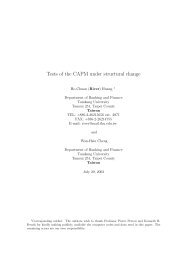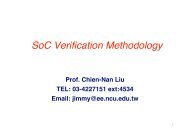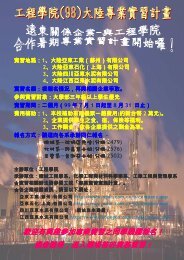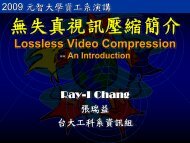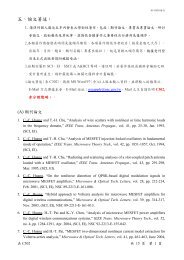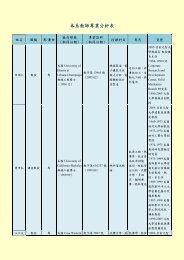- Page 1 and 2:
Star-Hspice Quick Reference Guide R
- Page 3 and 4:
AGREEMENT WITH AVANT! CORPORATION O
- Page 5 and 6:
1- Chapter 1 Introduction This Quic
- Page 7 and 8:
Input and Output Files Input and Ou
- Page 9 and 10:
.PARAMETER .END Input and Output Fi
- Page 11 and 12:
Input and Output Files tnom vt(t) v
- Page 13 and 14:
2- Chapter 2 Discrete Device Librar
- Page 15 and 16:
3- Chapter 3 Passive Devices and In
- Page 17 and 18:
n1 n2 R Rxxx SCALE TC1 TC2 user-def
- Page 19 and 20:
Capacitors M W L DTEMP C=‘equatio
- Page 21 and 22:
IC L=inductance L=‘equation’ LT
- Page 23 and 24:
Independent Source Element Lzzz Nam
- Page 25 and 26:
Pulse Source Function General Form
- Page 27 and 28:
Single-Frequency FM Source Function
- Page 29 and 30:
Independent Sources TIME tr v1 v2
- Page 31 and 32:
4- Chapter 4 Transmission Lines Sta
- Page 33 and 34:
5- Chapter 5 IBIS Conventions The t
- Page 35 and 36:
Buffers + [interpol={1|2}] + [ramp_
- Page 37 and 38:
Buffers I/O Open Drain, I/O Open Si
- Page 39 and 40:
Differential Pins + [buffer={13|io_
- Page 41 and 42:
6- Chapter 6 Diodes The topics cove
- Page 43 and 44:
Junction Model Statement WP Width o
- Page 45 and 46:
Junction Model Parameters Name (Ali
- Page 47 and 48:
Junction Cap Model nodeplus nminus
- Page 49 and 50:
Junction Cap Model Name (Alias) Uni
- Page 51 and 52:
Junction Cap Model Name (Alias) Uni
- Page 53 and 54:
Temperature Effects Temperature Eff
- Page 55 and 56:
Fowler-Nordheim Diode Name (Alias)
- Page 57 and 58:
Fowler-Nordheim Diode Name (Alias)
- Page 59 and 60:
7- Chapter 7 BJT Element The topics
- Page 61 and 62:
BJT Model Parameters mname NPN pnam
- Page 63 and 64:
BJT Model Parameters Low-Current Be
- Page 65 and 66:
See “Using Parasitic Resistance P
- Page 67 and 68:
BJT Model Parameters Transit Time P
- Page 69 and 70:
LEVEL 6 Philips Bipolar Model LEVEL
- Page 71 and 72:
LEVEL 6 Philips Bipolar Model Param
- Page 73 and 74:
LEVEL 6 Philips Bipolar Model Param
- Page 75 and 76:
LEVEL 6 Philips Bipolar Model Param
- Page 77 and 78:
LEVEL 6 Philips Bipolar Model Flags
- Page 79 and 80:
Avalanche Model Parameters - Level
- Page 81 and 82:
Base-Emitter Capacitances - Level 5
- Page 83 and 84:
Transit Time Parameters - Level 504
- Page 85 and 86:
LEVEL 6 Philips Bipolar Model Noise
- Page 87 and 88: LEVEL 8 HiCUM Model LEVEL - 8 HiCUM
- Page 89 and 90: LEVEL 8 HiCUM Model BE Depletion Ca
- Page 91 and 92: LEVEL 8 HiCUM Model Critical Curren
- Page 93 and 94: LEVEL 8 HiCUM Model Parameter Unit
- Page 95 and 96: LEVEL 8 HiCUM Model BE Tunneling Pa
- Page 97 and 98: LEVEL 8 HiCUM Model Substrate Trans
- Page 99 and 100: LEVEL 8 HiCUM Model Parameter Unit
- Page 101 and 102: LEVEL 8 HiCUM Model Parameter Unit
- Page 103 and 104: 8- Chapter 8 Elements This chapter
- Page 105 and 106: JFET and MESFET Model Statements JF
- Page 107 and 108: JFET Model Parameters Name (Alias)
- Page 109 and 110: JFET Model Parameters Name (Alias)
- Page 111 and 112: JFET Model Parameters Name (Alias)
- Page 113 and 114: 9- Chapter 9 MOSFET Introduction Th
- Page 115 and 116: MOSFET Element Statement RDC RSC W
- Page 117 and 118: MOSFET Element Statement Capacitanc
- Page 119 and 120: MOSFET Element Statement Name (Alia
- Page 121 and 122: MOSFET Element Statement Name (Alia
- Page 123 and 124: MOSFET Element Statement Name (Alia
- Page 125 and 126: Charge Conservation Parameters (CAP
- Page 127 and 128: MOSFET Element Statement Name (Alia
- Page 129 and 130: 10- Chapter 10 MOSFET Models This c
- Page 131 and 132: Model Table LEVEL MOSFET Model Desc
- Page 133 and 134: Model Table LEVEL MOSFET Model Desc
- Page 135 and 136: LEVEL 47 BSIM3 Version 2 MOS Model
- Page 137: LEVELs 49 and 53 BSIM3v3 MOS Models
- Page 141 and 142: LEVEL 55 EPFL-EKV MOSFET Model LEVE
- Page 143 and 144: LEVEL 57 UC Berkeley BSIM3-SOI Mode
- Page 145 and 146: LEVEL 57 UC Berkeley BSIM3-SOI Mode
- Page 147 and 148: LEVEL 57 UC Berkeley BSIM3-SOI Mode
- Page 149 and 150: LEVEL 57 UC Berkeley BSIM3-SOI Mode
- Page 151 and 152: LEVEL 58 University of Florida SOI
- Page 153 and 154: LEVEL 59 UC Berkeley BSIM3-SOI FD M
- Page 155 and 156: LEVEL 60 UC Berkeley BSIM3-SOI DD M
- Page 157 and 158: LEVEL 62 RPI Poli-Si TFT Model •
- Page 159 and 160: 11- Chapter 11 Behavior Macromodeli
- Page 161 and 162: G Elements Voltage Controlled Curre
- Page 163 and 164: Voltage and Current Controlled Elem
- Page 165 and 166: Voltage and Current Controlled Elem
- Page 167 and 168: Voltage and Current Controlled Elem
- Page 169 and 170: Voltage and Current Controlled Elem
- Page 171 and 172: F Element Parameters Voltage and Cu
- Page 173 and 174: Voltage and Current Controlled Elem
- Page 175 and 176: Voltage and Current Controlled Elem
- Page 177 and 178: 12- Chapter 12 Controlling Input Th
- Page 179 and 180: General Control Options Option NOEL
- Page 181 and 182: General Control Options Interface O
- Page 183 and 184: General Control Options Error Optio
- Page 185 and 186: Model Analysis Options Option DEFNR
- Page 187 and 188: Model Analysis Options Option RELMO
- Page 189 and 190:
Model Analysis Options Option DCSTE
- Page 191 and 192:
Model Analysis Options Option PZTOL
- Page 193 and 194:
Model Analysis Options Option RELTO
- Page 195 and 196:
Model Analysis Options Option RELVA
- Page 197 and 198:
Statements Statements Star-Hspice s
- Page 199 and 200:
Statements pnami colnum fileout pva
- Page 201 and 202:
Statements elname Element name that
- Page 203 and 204:
.LIB Library File Definition Statem
- Page 205 and 206:
Statements VERSION Star-Hspice vers
- Page 207 and 208:
.TITLE Statement See “Title of Si
- Page 209 and 210:
13- Chapter 13 Analyzing Data You c
- Page 211 and 212:
DC Analysis incr1 … MODEL MONTE=v
- Page 213 and 214:
AC Analysis See “.TF Statement
- Page 215 and 216:
stop SWEEP TEMP type var .DISTO Sta
- Page 217 and 218:
Small-Signal Network Analysis .NET
- Page 219 and 220:
Double-Point Analysis General Form
- Page 221 and 222:
tstop1… type UIC var FFT Analysis
- Page 223 and 224:
Worst Case Analysis Numerical Integ
- Page 225 and 226:
Worst Case Analysis AC Sweep Genera
- Page 227 and 228:
14- Chapter 14 Optimizing Data This
- Page 229 and 230:
.MODEL Statement Syntax General For
- Page 231 and 232:
Laplace Transforms Voltage Gain H(s
- Page 233 and 234:
15- Chapter 15 Output Format The to
- Page 235 and 236:
Graphing Results in AvanWaves Setup
- Page 237 and 238:
Print Commands Graph Commands A, D
- Page 239 and 240:
See “.GRAPH Statement” in the S
- Page 241 and 242:
Print Commands Target General Form
- Page 243 and 244:
Print Commands out_var result TO WE
- Page 245 and 246:
Print Commands YMAX If the absolute
- Page 247 and 248:
DC and Transient Output out_var(1,2
- Page 249 and 250:
AC Analysis Output AC Analysis Outp
- Page 251 and 252:
Element Template Output ZIN ZOUT In
- Page 253 and 254:
Element Template Listings Name Alia
- Page 255 and 256:
Element Template Listings Independe
- Page 257 and 258:
Element Template Listings Name Alia
- Page 259 and 260:
Element Template Listings Name Alia
- Page 261 and 262:
Element Template Listings Name Alia
- Page 263 and 264:
Element Template Listings Name Alia
- Page 265 and 266:
Element Template Listings Name Alia



